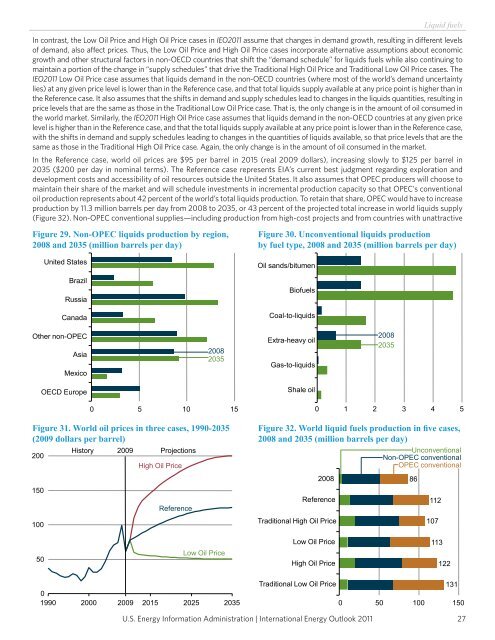International Energy Outlook 2011 - EIA
International Energy Outlook 2011 - EIA
International Energy Outlook 2011 - EIA
You also want an ePaper? Increase the reach of your titles
YUMPU automatically turns print PDFs into web optimized ePapers that Google loves.
U.S. <strong>Energy</strong> Information Administration | <strong>International</strong> <strong>Energy</strong> <strong>Outlook</strong> <strong>2011</strong><br />
Liquid fuels<br />
In contrast, the Low Oil Price and High Oil Price cases in IEO<strong>2011</strong> assume that changes in demand growth, resulting in different levels<br />
of demand, also affect prices. Thus, the Low Oil Price and High Oil Price cases incorporate alternative assumptions about economic<br />
growth and other structural factors in non-OECD countries that shift the “demand schedule” for liquids fuels while also continuing to<br />
maintain a portion of the change in “supply schedules” that drive the Traditional High Oil Price and Traditional Low Oil Price cases. The<br />
IEO<strong>2011</strong> Low Oil Price case assumes that liquids demand in the non-OECD countries (where most of the world’s demand uncertainty<br />
lies) at any given price level is lower than in the Reference case, and that total liquids supply available at any price point is higher than in<br />
the Reference case. It also assumes that the shifts in demand and supply schedules lead to changes in the liquids quantities, resulting in<br />
price levels that are the same as those in the Traditional Low Oil Price case. That is, the only change is in the amount of oil consumed in<br />
the world market. Similarly, the IEO<strong>2011</strong> High Oil Price case assumes that liquids demand in the non-OECD countries at any given price<br />
level is higher than in the Reference case, and that the total liquids supply available at any price point is lower than in the Reference case,<br />
with the shifts in demand and supply schedules leading to changes in the quantities of liquids available, so that price levels that are the<br />
same as those in the Traditional High Oil Price case. Again, the only change is in the amount of oil consumed in the market.<br />
In the Reference case, world oil prices are $95 per barrel in 2015 (real 2009 dollars), increasing slowly to $125 per barrel in<br />
2035 ($200 per day in nominal terms). The Reference case represents <strong>EIA</strong>’s current best judgment regarding exploration and<br />
development costs and accessibility of oil resources outside the United States. It also assumes that OPEC producers will choose to<br />
maintain their share of the market and will schedule investments in incremental production capacity so that OPEC’s conventional<br />
oil production represents about 42 percent of the world’s total liquids production. To retain that share, OPEC would have to increase<br />
production by 11.3 million barrels per day from 2008 to 2035, or 43 percent of the projected total increase in world liquids supply<br />
(Figure 32). Non-OPEC conventional supplies—including production from high-cost projects and from countries with unattractive<br />
Figure 29. Non-OPEC liquids production by region,<br />
2008 and 2035 (million barrels per day)<br />
200<br />
150<br />
100<br />
50<br />
United States<br />
Brazil<br />
Russia<br />
Canada<br />
Other non-OPEC<br />
Asia<br />
Mexico<br />
OECD Europe<br />
0 5 10 15<br />
Figure 31. World oil prices in three cases, 1990-2035<br />
(2009 dollars per barrel)<br />
History 2009 Projections<br />
High Oil Price<br />
Reference<br />
2008<br />
2035<br />
Low Oil Price<br />
0<br />
1990 2000 2009 2015 2025 2035<br />
Figure 30. Unconventional liquids production<br />
by fuel type, 2008 and 2035 (million barrels per day)<br />
Oil sands/bitumen<br />
Biofuels<br />
Coal-to-liquids<br />
Extra-heavy oil<br />
Gas-to-liquids<br />
Shale oil<br />
2008<br />
Reference<br />
Traditional High Oil Price<br />
Low Oil Price<br />
High Oil Price<br />
Traditional Low Oil Price<br />
2008<br />
2035<br />
0 1 2 3 4 5<br />
Figure 32. World liquid fuels production in five cases,<br />
2008 and 2035 (million barrels per day)<br />
Unconventional<br />
Non-OPEC conventional<br />
OPEC conventional<br />
86<br />
112<br />
107<br />
113<br />
122<br />
131<br />
0 50 100 150<br />
27

















